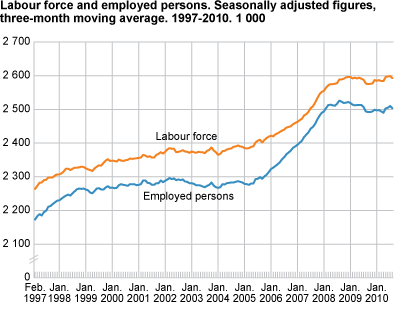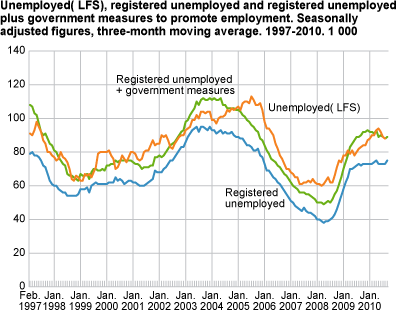Content
Published:
This is an archived release.
Lower labour force participation
From the 3r d quarter of 2009 to the 3r d quarter of 2010 the labour force participation fell from 72.6 per cent to 71.9 per cent. The reduction came especially among the young.
Seasonally-adjusted figures: stable labour marketBoth employment and unemployment remained stable from the 2n d quarter to the 3r d quarter of 2010. The unemployment rate in August was 3.4 per cent. Adjustments for seasonal variations allow for the analysis of current developments in the labour market, and serve as an alternative to comparisons with the corresponding quarter in the previous year. Seasonally-adjusted figures are presented in a separate article . |
Between the 3r d quarter of 2009 and the 3r d quarter of 2010 the labour force participation among people below the age of 30 was reduced by 2 percentage points. The reduction was especially high within the age group 20-24. In the 3r d quarter of 2010, 72.7 per cent of this age group was in the labour force; a reduction of 2.5 percentage points from the year before.
Both men and women had their labour force participation reduced in the period. In the 3r d quarter of 2010 the labour force participation among women was 68.8 per cent, and among men 75 per cent.
|
The labour force is the sum of employed and unemployed between 15-74 years of age. From the third quarter of 2009 to the third quarter of 2010 the LFS shows that employment rose by about 11 000 persons and unemployment rose by 8 000 persons. This gives an increase in the labour force on the higher edge of 18 000 persons. The coherence between the conceptsUnemployed + Employed = Labour force Labour force + Outside the labour force = Population |
Outside the labour force
The working-age population (15-74) increased by 60 000 persons, which signifies that the increase in the number outside the labour force was 42 000. Of the persons outside the labour force, 26 000 more persons had education as their main activity, while 25 000 more persons were early retired/disabled or retired.
Increase in employment within human health and social work activities
From the 3r d quarter of 2009 to the 3r d quarter of 2010, employment rose by 11 000 people. Human health and social work activities had an increase of 17 000 people. Manufacturing had a decrease of 13 000 in the same period. There were only small changes in the other major industries.
More persons on temporary contracts in construction
According to the LFS, there were 6 000 more people on temporary contracts in the 3rd quarter of 2010 compared with the corresponding quarter in 2009. In the 3r d quarter of 2010, 205 000 people were on temporary contracts, which amounts to 8.8 per cent of total employment in the 3r d quarter 2010.
Increase in long-term unemployment
From the 3r d quarter of 2009 to the 3r d quarter of 2010, the number of unemployed increased by 8 000 people. In the 3r d quarter of 2010 the unemployed searched on average for jobs for 26.5 weeks. This is an increase of 6.3 weeks since the corresponding quarter of 2009. The increase is a result of long-term unemployment. The share of long-term unemployment increased from 27 per cent in the 3r d quarter of 2009 to 31 per cent in 2010. Of a total of 92 000 unemployed persons in the 3r d quarter of 2010, 26 000 persons were long-term unemployed. Long- term unemployed are people who have been out of work for more than 26 weeks.
More underemployed
The number of underemployed increased by 7 000 persons from the 3r d quarter of 2009 to the 3r d quarter of 2010. Underemployment is employees with part-time contractual working hours who have tried to find more work. The number of underemployed was 69 000 in the 3r d quarter of 2010.
Together, the groups of underemployed and unemployed wanted work corresponding to 105 000 full-time equivalents in the second quarter of 2010; up 10 000 from the year before.
Tables:
- Table 1. Population aged 15-74 by labour force status(LFS) and sex. 1000
- Table 2. Population aged 15-74 by labour force status (LFS) and sex. Changes from the same period inthe previous year. 1000
- Table 3. Population aged 15-74 by labour force status(LFS) and sex. Per cent
- Table 4. Persons in the labour force and employed persons aged 15-74, by age and sex (LFS). 1000
- Table 5. Persons in the labour force and employed persons aged 15-74, by age and sex (LFS). In per cent of the population
- Table 6. Persons aged 15-74, employed persons by contractual/usual working hours per week1 and unemployedpersons by age and sex (LFS). 1000
- Table 7. Persons in the labour force aged 15-74 by age and sex (LFS). 1 000. 1000
- Table 8. Persons in the labour force aged 15-74 by age and sex (LFS). As per cent of all in each group'
- Table 9. Employed persons aged 15-74 by sex and contractual/usual working hours per week (LFS). 1 000
- Table 10. Population aged 15-74, by main activity, part-time employment and age (LFS). 1 000
- Table 11. Employed persons aged 15-74 by major industry division (LFS). 1 000
- Table 12. Average number of man-weeks worked2(37,5 hours), by industry division (LFS). 1 000
- Table 13. Employed persons aged 15-74 and average number of man-weeks worked1(a 37.5 hours)by sex and status. 1000. Actual working hours, by sex and status. Hours per week.
- Table 14. Employed persons aged 15-74 and absence from work1 during the whole reference weekby reason for absence and sex (LFS). 1 000
- Table 15. Employed persons aged 15-74 and absence from work1 during the whole reference weekby reason for absence and sex (LFS). Per Cent
- Table 16. Employees aged 15-74 with temporary jobs, by major industry division (LFS). 1000
- Table 17. Employees aged 15-74 with temporary jobs, by major industry division (LFS).In per cent of all employees
- Table 18. Unemployed persons aged 15-74 by sex and age (LFS). 1000 and per cent
- Table 19. Unemployed persons aged 15-74 by duration of job search (LFS). 1 000 and per cent
- Table 20. Unemployed persons aged 15-74, by main activity (LFS). 1 000
- Table 21. Unemployed and underemployed persons aged 15-74, by sex and desired working hours per week.Number of man-weeks (of 37,5 hours) supplied'
- Table 23. Employed persons aged 15-74, by sex and region (LFS) 1 000
- Tabell 24. Employed persons aged 15-74, by sex and regions (LFS) as per cent of all inn each group
Contact
-
Arbeidsmarked og lønn
E-mail: arbeidsmarked@ssb.no
-
Erik Herstad Horgen
E-mail: erik.horgen@ssb.no
tel.: (+47) 93 08 68 62
-
Håvard Hungnes Lien
E-mail: havard.lien@ssb.no
tel.: (+47) 40 90 26 06


